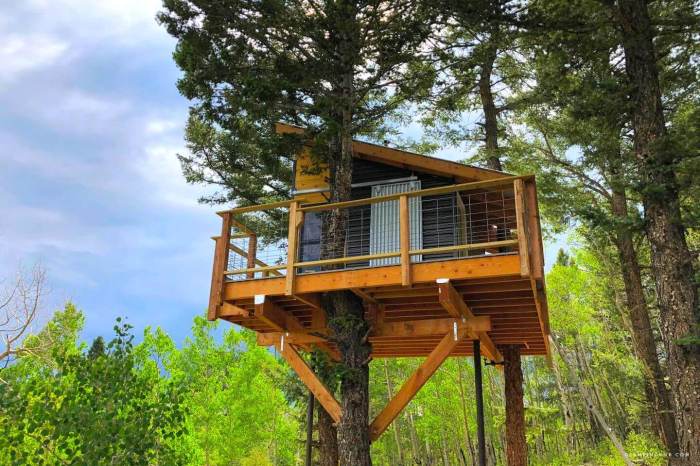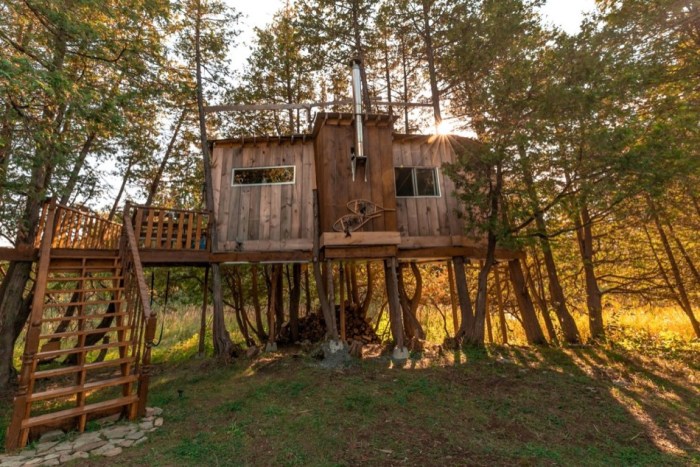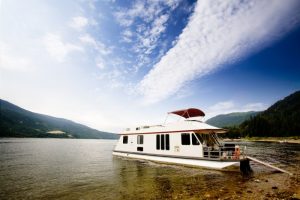
Off-the-grid treehouses offer a captivating escape from the ordinary, promising an immersive experience in nature’s embrace. These unique dwellings, often nestled in secluded forests or mountainous regions, provide a chance to disconnect from modern conveniences and reconnect with the natural world. This exploration delves into the design, construction, environmental impact, and overall experience of living—or vacationing—in these remarkable structures.
From the meticulous planning involved in their construction, which often prioritizes sustainability and minimal environmental impact, to the daily routines and adventurous activities available to those who choose this unique lifestyle, off-grid treehouses present a compelling alternative to traditional accommodations. We will examine the various types of off-grid treehouses, compare them to other unique lodging options, and provide practical guidance for those considering a stay or even building their own.
Finding and Booking Off-the-Grid Treehouses

Securing your dream off-the-grid treehouse escape requires a strategic approach. This guide will equip you with the necessary tools and knowledge to find and book the perfect secluded retreat, ensuring a memorable and stress-free experience. We’ll cover key resources, essential considerations, and smart booking strategies.
Resources and Platforms for Finding Off-the-Grid Treehouses
Several online platforms specialize in unique accommodations, including off-the-grid treehouses. These resources offer diverse listings, detailed descriptions, and user reviews, allowing you to compare options effectively. Popular choices include Airbnb, VRBO (Vacation Rentals By Owner), Glamping Hub, and specialized eco-tourism websites. Additionally, direct searches on Google Maps and dedicated travel blogs can uncover hidden gems not listed on mainstream platforms.
Remember to carefully review each listing’s description and photos, paying close attention to details regarding accessibility, amenities, and the level of isolation.
Factors to Consider When Selecting an Off-the-Grid Treehouse
Choosing the right off-the-grid treehouse involves careful consideration of several key factors. Location plays a crucial role; consider proximity to desired activities, scenic views, and your tolerance for remoteness. Amenities are another important aspect; assess the availability of essentials like running water, electricity (solar or otherwise), cooking facilities, and sanitation. Accessibility should be carefully evaluated, considering your physical capabilities and the treehouse’s access route.
Finally, consider the overall ambiance and aesthetic, ensuring it aligns with your desired level of comfort and seclusion.
Negotiating Prices and Securing the Best Deals, Off-the-grid treehouses
While off-the-grid treehouses often command premium prices, there are strategies to secure better deals. Booking during the off-season or shoulder seasons can significantly reduce costs. Flexible travel dates also increase your bargaining power. Directly contacting the owners or property managers can open opportunities for negotiation, especially for longer stays or group bookings. Look for special offers or discounts promoted on booking platforms or the property’s website.
Lastly, consider the overall value proposition, balancing price with the unique experience and amenities offered.
Off-the-Grid Treehouses vs. Other Unique Accommodations

Choosing a unique accommodation for your next getaway can be exciting, but the sheer variety of options can be overwhelming. This comparison focuses on off-the-grid treehouses and how they stack up against other popular choices like yurts, cabins, and glamping sites, considering cost, amenities, and accessibility. Understanding the nuances of each will help you make an informed decision that best suits your needs and preferences.
Comparison of Unique Accommodation Types
The following table provides a direct comparison of off-grid treehouses, yurts, cabins, and glamping sites across key characteristics. Note that prices and amenities can vary significantly based on location, specific property, and time of year.
| Accommodation Type | Cost | Amenities | Location Accessibility |
|---|---|---|---|
| Off-Grid Treehouse | Generally higher than cabins, comparable to luxury glamping; varies greatly based on location and features. Expect to pay upwards of $200 per night for a basic setup, potentially reaching several thousand for high-end options. | Often basic, focusing on nature immersion. May include solar power, composting toilet, rainwater collection, basic cooking facilities. Amenities are usually limited to enhance the off-grid experience. | Typically remote, requiring some level of hiking or driving on unpaved roads. Accessibility varies greatly. |
| Yurt | Mid-range; often less expensive than treehouses but more than basic cabins. Prices vary depending on size, location, and amenities. Expect to pay between $100-$300 per night. | Can range from basic (bed, heating) to luxurious (private bathroom, kitchen). Often located on established campgrounds or private land, offering a balance between nature and convenience. | Generally easier to access than treehouses, often located within driving distance of amenities. |
| Cabin | Wide range; from budget-friendly to luxurious. Basic cabins can cost as little as $50 per night, while high-end options can reach several hundred. | Highly variable; can range from very basic (bed, heating) to fully equipped (kitchen, bathroom, Wi-Fi). Location influences amenities significantly. | Accessibility varies; can be remote or conveniently located near towns and attractions. |
| Glamping Site | Mid-range to high-end; often comparable to treehouses or luxury cabins. Prices vary significantly based on the type of glamping accommodation (e.g., safari tent, yurt, cabin). Expect to pay $150-$500+ per night. | Generally offers a balance between comfort and nature. Common amenities include comfortable beds, private bathrooms, and sometimes kitchen facilities. Many glamping sites offer additional amenities such as hot tubs or fire pits. | Accessibility varies; some are remote, while others are easily accessible. |
Advantages and Disadvantages of Each Accommodation Type
Each accommodation type offers unique advantages and disadvantages that cater to different preferences and needs. For instance, off-grid treehouses provide unparalleled immersion in nature, but this comes at the cost of limited amenities and accessibility. Yurts offer a good balance between comfort and nature, while cabins offer a wide range of options from basic to luxurious. Glamping sites prioritize comfort and often provide a range of amenities, but may not offer the same level of seclusion as other options.
Target Audience for Each Accommodation Type
Off-grid treehouses appeal to adventurous nature lovers seeking a truly immersive experience, prioritizing seclusion and a connection with nature over comfort and convenience. Yurts attract those seeking a balance between comfort and nature, suitable for families or couples who appreciate a unique stay without sacrificing too much convenience. Cabins are a versatile choice, attracting a broad audience ranging from budget travelers to those seeking comfortable lodging in scenic locations.
Glamping sites cater to those who desire a luxurious experience in nature, offering comfort and amenities without sacrificing the outdoorsy feel.
Travel Planning for Off-the-Grid Experiences (Related to other travel types)
Integrating an off-the-grid treehouse stay into a larger travel itinerary can significantly enhance your adventure. It offers a unique contrast to more conventional accommodations and activities, providing a refreshing change of pace and a deeper connection with nature. Planning effectively involves considering transportation, budgeting, and the integration of various travel styles to create a seamless and memorable experience.Successfully incorporating off-grid treehouse stays requires careful planning across different travel aspects.
This includes securing cost-effective transportation, balancing budget accommodations with luxurious treehouse experiences, and designing itineraries that blend adventurous off-grid time with city exploration or other activities. Strategic planning is key to a truly fulfilling trip.
Integrating Off-Grid Stays into Broader Travel Plans
Combining off-the-grid treehouse stays with other travel experiences is straightforward with proper planning. For instance, a Pacific Northwest road trip could incorporate a treehouse stay nestled in the Olympic National Forest, followed by exploring Seattle’s vibrant city life. Similarly, a European adventure might involve a scenic train journey to a remote region, followed by a relaxing treehouse stay near a national park before moving on to a bustling city like Paris.
The possibilities are endless, depending on your preferences and budget.
Examples of Itineraries Combining Off-Grid Stays with Other Experiences
Here are two example itineraries illustrating how to integrate off-the-grid treehouse stays:
Itinerary 1: National Park Adventure
Day 1-3: Fly into Denver, Colorado. Rent a car and drive to Rocky Mountain National Park. Hike, camp, and enjoy the park’s stunning scenery.
Day 4-6: Drive to a secluded area near the park and spend two nights in a luxurious off-grid treehouse. Relax, unwind, and enjoy the peace and quiet of nature.
Day 7-8: Drive back to Denver, explore the city, and fly home.
Itinerary 2: Coastal Exploration and Relaxation
Day 1-2: Take a train from London to Cornwall, England. Explore the coastal towns and enjoy the beautiful scenery.
Day 3-5: Stay in a charming off-grid treehouse overlooking the ocean. Enjoy breathtaking sunsets and the tranquility of the coastal environment.
Day 6-7: Travel to London by train, visit famous landmarks, and depart from Heathrow Airport.
Sample Travel Blog Post Incorporating Off-the-Grid Treehouse Experiences
Imagine this blog post title: “From Budget Backpacker to Luxurious Treetop Haven: My Epic Multi-Modal Adventure!”
The post would begin with a captivating introduction describing the thrill of combining different travel styles. It would then detail the planning process, starting with finding incredible flight deals using websites like Skyscanner and Google Flights. The author might share a personal anecdote about snagging a last-minute deal on a train journey through the Swiss Alps, highlighting the scenic beauty and cost savings.
A section could be dedicated to their road trip across the American Southwest, emphasizing the freedom and flexibility of this mode of travel. The core of the blog would focus on the off-grid treehouse experience, describing the unique charm and tranquility of the accommodation, contrasting it with previous stays in budget hostels, Airbnb rentals, and even a luxury hotel in a major city.
The post would also include a review of a cruise ship experience, discussing the pros and cons, and compare that to the unique appeal of a houseboat stay on a secluded lake. Finally, the author could conclude with reflections on the entire adventure, emphasizing the value of blending different travel styles to create a truly unforgettable and enriching journey. The post would be filled with stunning visuals, illustrating each aspect of the journey – from breathtaking landscapes to cozy treehouse interiors and vibrant cityscapes.
Ultimately, off-the-grid treehouses represent more than just a unique form of accommodation; they embody a philosophy of sustainable living and a desire for a deeper connection with nature. Whether you’re drawn to the adventurous spirit of exploring remote locations or the simple pleasure of disconnecting from technology and embracing a slower pace of life, the allure of an off-grid treehouse stay promises an unforgettable experience.
This exploration has highlighted the planning, construction, environmental considerations, and overall appeal of these remarkable dwellings, showcasing their potential as a sustainable and enriching travel alternative.
Commonly Asked Questions
What are the typical costs associated with staying in an off-grid treehouse?
Costs vary significantly depending on location, amenities, and the length of stay. Expect to pay more for remote, luxurious treehouses with extensive amenities.
How do I ensure my safety in a remote off-grid treehouse?
Research the location thoroughly, inform someone of your plans, and carry necessary safety equipment, such as first-aid kits and communication devices. Choose reputable rental providers with good safety records.
What about accessibility for individuals with disabilities?
Accessibility varies greatly. Many off-grid treehouses are not designed for individuals with mobility challenges due to their remote locations and often rustic design. Always check accessibility features before booking.
What are the typical power sources for off-grid treehouses?
Common power sources include solar panels, wind turbines, and generators. The specific source will depend on the treehouse and its location.




